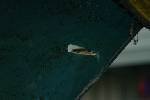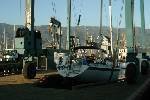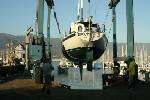The yard that did mine is an OEM as well as a repair yard and seem knowledgeable. They advise a really good adhesive-sealant, and 5200 is that, for sure.
Note that most owners, despite what they read and see on forums like this will never have a keel rebedded while they own their boat. Preventative Maintenance is not a hot conversation topic around the ol' yacht club bar!

With a schedule of, say 15 to 20 years, for a keel rebed, I would prefer to go with the highest grade of sealant available. OTOH, you might certainly have to drive some wood or plastic wedges in after the nuts are off to get 'er to drop, next time around.
Having seen how well ours was re-attached, I would be inclined to wait the full 20 years to repeat that process... to express it in round numbers.
After seeing those pics on this site of badly-corroded bolts, after a bit over 20 years of salt water festering within the mating surface area, periodic rebedding just seems like something that should be done -- before you have a "problem." I liken it to replacing my standing rigging well before it fails or threatens to fail.
Advice free, and worth about what you pay.

Loren






